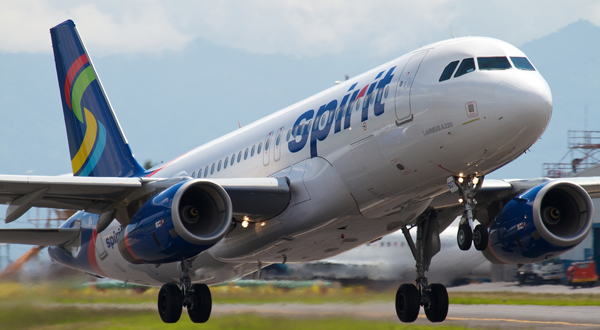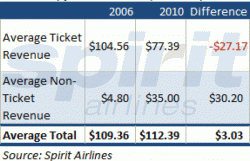Spirit Airlines is growing fast

On its first-ever earnings conference call Thursday, newly-public Spirit Airlines sounded nothing like the half-dozen established airlines whose calls came earlier.
To begin with, Spirit is growing. Capacity grew 27.3% in the second quarter, with full-year growth pegged at 16%. The carrier has 35 Airbus aircraft and will take two more this fall, seven a year from 2012 through 2014 and 10 in 2015. That will enable growth of 15% to 20% for several years.
By contrast, the rest of the industry is infatuated by capacity control. Delta, for instance, won plaudits from Wall Street after saying Wednesday that it will shrink capacity by 4% to 5%, an incremental one point reduction from previous guidance.
In a report on Delta, Dahlman Rose analyst Helane Becker suggested other carrier should follow Delta’s lead. “It can’t be done alone,” she wrote.
Spirit is headed the other way not just in capacity but also in pricing, route planning, passenger profiling and financials. For instance, Spirit has $347 million in cash and zero debt. In pricing, the most distinctive difference, the philosophy is to charge the lowest possible fares, but to make money by charging fees. During the quarter, revenue per flight segment grew 14% to $125. Growth came from the non-ticket or fee revenue, which grew 37% to $43.
 Currently, a third of revenue derives from ticket sales, and about half of the ticket sale revenue pays for fuel. The goal, said CEO Ben Baldanza on the earnings call, is to directly pass fuel cost on to the consumer, and then to fund remaining costs and profit from ancillary revenue. Spirit has a lot more ideas, so far undisclosed, to raise ancillary revenue, he said.
Currently, a third of revenue derives from ticket sales, and about half of the ticket sale revenue pays for fuel. The goal, said CEO Ben Baldanza on the earnings call, is to directly pass fuel cost on to the consumer, and then to fund remaining costs and profit from ancillary revenue. Spirit has a lot more ideas, so far undisclosed, to raise ancillary revenue, he said.
Unlike others, Spirit doesn’t care about yield, or ticket revenue. “We don’t manage because of yield,” said Baldanza. “That is a metric for other models.” Rather, he said, Spirit looks at total revenue per available seat mile “as the relevant piece [because] we see non-ticket and ticket revenue as equally important.”
On route selection, Spirit isn’t wedded to any particular region or hub or market type. In the second quarter, it added routes from Fort Lauderdale, Las Vegas and Myrtle Beach, all leisure markets. But it also began Chicago-Los Angeles and announced new routes from Chicago to Boston, Dallas, Detroit and New York, generally viewed as business markets. “We look for routes we think will make money, [not] market share, size of city, or 100 flights a day,” Baldanza said. “There’s no metric. All of our routes make money, that’s the relationship.”
Senior Vice President Barry Biffle said other carriers won’t retaliate because Spirit doesn’t seek out the business passengers they covet. “JetBlue and Virgin are chasing American and Delta business customers,” he said. “We’re not chasing the business customer [so] we’re not a threat. In Los Angeles-Chicago, there are a lot more grandmothers going to see their kids.”
A recent move by American to add winter capacity in Fort Lauderdale spooked investors, but Biffle said American adds Fort Lauderdale capacity every year. Los Angeles-Fort Lauderdale, one of three new American routes, already has three low-fare carriers, he noted.
Spirit also looks at its passengers differently. Other carriers like to retain them. Spirit likes to retain them too, but doesn’t have the same expectations. “We appeal to a lot of customers who fly once or twice a year,” Biffle said. “We won’t have the repeat customers you will see at a legacy carrier.”
In early afternoon trading, Spirit shares were up 61 cents to $13.25. The 5% gain was leading the airline sector. Spirit went public on May 26 at $12 a share. On its first day of trading, it closed at 11.55.
In the second quarter, Spirit earned $26.8 million or 37 cents a share, excluding items. In the same quarter a year earlier, as a private company, Spirit lost $10.1 million, a loss of 38 cents a share. Revenue rose 56% to $276 million; In June 2010, revenue was diminished by a pilot strike. RASM rose 22% to 11.37 cents. Traffic rose 37% on a capacity increase of 27%, resulting in an 86% load factor.
